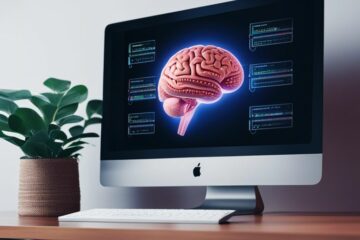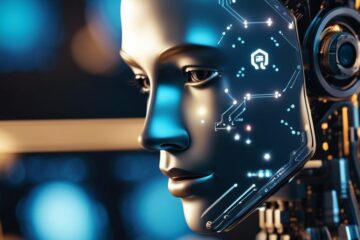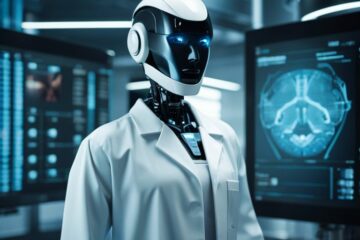Over the past few years, Artificial Intelligence (AI) has become a hot topic across various industries, sparking both excitement and concern. From self-driving cars to personalized recommendations on streaming platforms, AI has seamlessly integrated into our daily lives. But what exactly is AI, and how does it work?
AI refers to the simulation of human intelligence by computer systems. This involves processes such as learning, reasoning, and self-correction. What sets AI apart is its ability to analyze massive amounts of data at speeds impossible for humans to achieve. While the possibilities for AI seem endless, there are also concerns about privacy, job displacement, and the ethical implications of AI.
This ultimate guide will examine into the intricacies of AI, from its inception to its current applications. We’ll explore the different types of AI, how it’s transforming various industries, and the potential risks and rewards associated with this rapidly advancing technology. Whether you’re a novice curious about AI or a seasoned professional looking to deepen your understanding, this guide will provide you with a comprehensive overview of Artificial Intelligence.
Key Takeaways:
- Artificial Intelligence (AI) is the simulation of human intelligence processes by machines, particularly computer systems.
- AI technologies include machine learning, natural language processing, robotics, expert systems, and more.
- Machine learning is a subset of AI that enables machines to learn and improve from experience without being explicitly programmed.
- AI applications are vast and include chatbots, self-driving cars, image recognition, healthcare diagnostics, and personalized recommendations.
- AI ethics is a crucial aspect to consider, as it involves the responsible use of AI to ensure fairness, accountability, and transparency.
- The future of AI holds promising advancements, but also raises concerns about job displacement, privacy, and security.
- AI is transforming industries across the board, from healthcare and finance to entertainment and transportation, revolutionizing how we work and live.
Understanding the Basics of AI
Key Concepts and Terminology
There’s an array of key concepts and terminology that form the foundation of artificial intelligence. Understanding these terms is crucial for grasping the complexities of AI. Some of the fundamental concepts include machine learning, neural networks, natural language processing, and computer vision.
Machine learning is a subset of AI that enables machines to learn from data without being explicitly programmed. Neural networks are a system of hardware and software designed to mimic the operation of neurons in the human brain. Natural language processing allows machines to understand and generate human language, enabling applications like speech recognition and language translation. Computer vision enables machines to interpret and make sense of visual information like images and videos.
These concepts work together to power various AI applications, from chatbots and virtual assistants to autonomous vehicles and facial recognition systems. By understanding these key terms, you can better comprehend the inner workings of AI and its real-world applications.
How Artificial Intelligence Works
The rapid advancements in AI have been fueled by the convergence of big data, computational power, and advanced algorithms. There’s a wide range of AI techniques, from simple decision trees to complex deep learning neural networks. Artificial intelligence works by processing large amounts of data, identifying patterns and trends, and making decisions or predictions based on that data. This iterative learning process allows AI systems to continuously improve their performance over time.
AI systems can be trained using supervised, unsupervised, or reinforced learning methods. Supervised learning involves training a model on labeled data, while unsupervised learning involves finding patterns in unlabeled data. Reinforcement learning uses a reward-based system to train AI models through trial and error.
AI algorithms rely on statistical techniques and mathematical optimization to optimize their performance. By processing and analyzing vast amounts of data, AI systems can perform tasks that were once thought to be exclusive to human intelligence.
The Difference Between AI, Machine Learning, and Deep Learning
Terminology: Understanding the distinction between AI, machine learning, and deep learning is important for navigating the field of artificial intelligence. Artificial intelligence is the broader concept of machines carrying out tasks in a way that we would consider “smart”. Machine learning is a subset of AI that focuses on developing algorithms that allow machines to learn from data. Deep learning is a specialized subset of machine learning that uses neural networks with multiple layers to analyze and extract patterns from large amounts of data.
While AI encompasses a wide range of techniques and applications, machine learning and deep learning are specific approaches within the broader AI field. Machine learning algorithms are designed to improve their performance on a specific task over time, while deep learning algorithms excel at handling large, unstructured datasets. Understanding the nuances between these terms is crucial for understanding the advancements and capabilities of artificial intelligence technologies.
As technology continues to evolve, the boundaries between these terms may become more blurred, but having a solid grasp of the key differences will enable you to stay informed and make informed decisions when it comes to implementing AI solutions in your business or projects.
Types of Artificial Intelligence
Not all artificial intelligence is created equal. There are different types of AI that vary in their capabilities and functions. Understanding the various categories of artificial intelligence is crucial to grasping the potential of this rapidly advancing technology.
Narrow or Weak AI
Narrow or Weak AI refers to artificial intelligence that is designed for a specific task or set of tasks. This type of AI is focused on performing a narrow range of activities and does not possess the ability to think or learn beyond its programmed functions. Examples of narrow AI include virtual personal assistants like Siri and Alexa, as well as image recognition software.
One of the key characteristics of narrow AI is its limited scope of applicability. While these systems can excel at their designated tasks, they lack the flexibility and adaptability of more advanced forms of artificial intelligence. Narrow AI is prevalent in the technology we use every day, from email spam filters to recommendation algorithms on streaming platforms.
Despite its limitations, narrow AI plays a crucial role in powering many of the AI applications that have become integral to modern life. As researchers continue to push the boundaries of artificial intelligence, narrow AI serves as the foundation upon which more advanced systems are built.
General or Strong AI
Narrow AI stands in stark contrast to General or Strong AI, which represents a form of artificial intelligence that possesses the ability to understand, learn, and apply knowledge across a wide range of tasks. General AI is often described as having human-like cognitive abilities and the capacity for reasoning, problem-solving, and creativity.
This type of artificial intelligence is the holy grail of AI research, as it has the potential to revolutionize industries, accelerate scientific discovery, and even replicate human intelligence. While General AI exists primarily in science fiction, researchers continue to work towards developing systems that exhibit more general intelligence.
To date, achieving true General AI remains a daunting challenge due to the complexity of human cognition and the limitations of current technology. However, advancements in machine learning, neural networks, and cognitive computing have brought us closer to unlocking the full potential of General AI.
You may have heard the term “superintelligent” tossed around in discussions about artificial intelligence, but what exactly does it mean? Superintelligent AI refers to a hypothetical future AI system that surpasses human intelligence in virtually every way. This concept raises profound questions about the implications of creating a machine that is more intelligent than the collective intelligence of all humanity.
Superintelligent AI is the subject of much speculation and debate within the AI community, with experts offering varying opinions on the feasibility and potential risks associated with such a technology. Proponents argue that superintelligent AI could unlock unprecedented advancements in science, medicine, and technology, while skeptics warn of the existential risks posed by creating a superintelligent entity that may surpass human control.
As we continue to pursue advancements in artificial intelligence, the need to understand and distinguish between the different types of AI becomes increasingly important. Comparing the various forms of artificial intelligence can shed light on their capabilities, limitations, and ethical considerations, helping us navigate the complex landscape of AI technologies with greater clarity.
Comparing the Different Types
An vital aspect of comprehending artificial intelligence is comparing the different types and understanding how they differ in terms of capabilities and functionality. By examining the distinctions between narrow AI, general AI, and superintelligent AI, we can gain insights into the evolution of artificial intelligence and its potential impact on society.
Step-by-Step: How AI is Developed
Problem Identification and AI Suitability
Some of the first steps in developing an AI system involve identifying the problem that needs to be solved and determining if AI technology is the right solution. This phase involves understanding the specific task at hand, evaluating whether AI can effectively address the problem, and defining the desired outcomes. It is crucial to have a clear understanding of the problem domain and the goals of the AI system.
Next, the suitability of AI for the identified problem needs to be assessed. This involves considering factors such as the complexity of the problem, the availability of data for training, and the expected performance of the AI system. It is crucial to analyze if AI technology aligns with the requirements and constraints of the problem, ensuring that it is a viable and effective solution.
Lastly, during this phase, stakeholders collaborate to define metrics for success, establish a project plan, and allocate resources accordingly. This sets the foundation for the development process, guiding the subsequent steps towards creating a successful AI solution.
Data Collection and Processing
Step by step, once the problem is identified and AI suitability confirmed, the next crucial stage is data collection and processing. High-quality data is the lifeblood of AI systems, as they rely on vast amounts of data to learn and make decisions. Gathering relevant data sets and preprocessing them to ensure accuracy and consistency is crucial for the success of the AI model.
Data collection involves sourcing data from various internal and external repositories, ensuring it is diverse, representative, and comprehensive. Data processing tasks include cleaning the data to remove noise and errors, transforming it into a suitable format for analysis, and augmenting it to enrich the learning process. This phase lays the groundwork for training the AI model effectively.
Suitability of the collected and processed data is critical to the performance of the AI system. Data quality, relevance, and representativeness directly impact the accuracy and reliability of the model. It is crucial to continuously evaluate and refine the data sets throughout the development process to enhance the AI system’s performance.
Building the AI Model
Now, we probe into the core of AI development – building the AI model. This phase involves selecting the appropriate algorithms and techniques based on the problem requirements, data characteristics, and desired outcomes. Creating a robust architecture for the model and fine-tuning parameters are crucial steps to ensure optimal performance.
Processing the data and feeding it into the AI model for training is a critical task during this phase. The model learns patterns and makes predictions based on the input data, iterating through multiple cycles to improve its accuracy and performance. Regular evaluation and adjustments are made to enhance the model’s capabilities and address any shortcomings.
Throughout this stage, collaboration between data scientists, engineers, and domain experts is crucial to refine the model and optimize its performance. Continuous iteration and improvement lead to the development of a robust and effective AI system that can deliver valuable insights and outcomes.
Training the AI
Model training is a pivotal stage in AI development, where the AI system learns from the data to make predictions and decisions. This process involves feeding the model with labeled data, allowing it to adjust its parameters and internal settings to minimize errors and improve accuracy.
Collection of training data sets that are diverse, balanced, and representative is crucial to train the AI model effectively. The training phase often involves splitting the data into training and validation sets, testing the model’s performance on unseen data, and fine-tuning it to enhance its predictive capabilities.
Testing and refining the model through iterative training cycles is crucial to ensure that it can generalize well to new data and scenarios. Continuous monitoring and evaluation help in detecting any biases, inaccuracies, or performance issues, leading to a more robust and reliable AI system.
Testing and Validation
Some of the final stages of AI development involve testing and validating the AI system to ensure its functionality and performance. This phase includes rigorous testing against different data sets, scenarios, and edge cases to evaluate the model’s robustness and reliability.
Another aspect of testing involves validating the AI system’s outputs against ground truth or expert judgments to verify its accuracy and efficacy. This helps in identifying any discrepancies or errors in the model’s predictions and making necessary adjustments to improve its performance.
Validation and verification processes play a critical role in ensuring that the AI system meets the specified requirements, complies with ethical standards, and delivers trustworthy and unbiased results. It is crucial to conduct thorough testing and validation procedures before deploying the AI system in real-world applications.
Key Factors Influencing AI Performance
For any artificial intelligence (AI) system to perform effectively, there are several key factors that play a crucial role in determining its success. These factors can significantly impact the capabilities and limitations of an AI system, ultimately influencing its overall performance. Understanding these factors is imperative for developing and optimizing AI solutions for various applications.
Quality and Quantity of Data
Assuming that quality and quantity of data are crucial for AI performance. High-quality, diverse datasets are imperative for training AI models effectively. The more data available for training, the better the AI system can learn and generalize patterns. Inadequate or biased data can result in poor performance and unreliable predictions. To overcome this, collecting and preprocessing large volumes of high-quality data is imperative for enhancing AI performance.
Algorithms and Model Complexity
Algorithms play a critical role in determining the performance of an AI system. The choice of algorithms and the complexity of the model can greatly impact the system’s ability to process information and make accurate predictions. Advanced algorithms, such as deep learning networks, can extract intricate patterns from data, enabling more sophisticated AI capabilities. However, overly complex models can lead to overfitting and poor generalization. Balancing algorithm selection and model complexity is imperative for optimizing AI performance.
Computing Power and Resources
Quality computing power and resources are imperative for maximizing AI performance. The ability to process large amounts of data quickly and efficiently can significantly impact the speed and accuracy of AI systems. High-performance GPUs and specialized hardware accelerators are often used to boost computational power for training complex AI models. Additionally, access to cloud computing resources can provide scalability and flexibility for deploying AI solutions. Investing in high-quality computing resources is critical for achieving optimal AI performance.
Continual Learning and Adaptation
Learning and adapting over time are imperative for AI systems to maintain optimal performance. Systems that can continually update their models based on new data and feedback can improve accuracy and relevance over time. Continuous learning mechanisms, such as reinforcement learning and online training, enable AI systems to adapt to changing environments and evolving requirements. Powering AI systems with the ability to learn and adapt is crucial for ensuring sustained performance and relevance in dynamic applications.
Applications of AI Across Industries
Healthcare
To meet the increasing demand for quality healthcare services, AI is being employed in various ways across the industry. AI-powered tools are helping healthcare professionals in tasks like diagnosis, treatment planning, personalized medicine, and drug discovery. Machine learning algorithms analyze medical data to identify patterns and insights that aid in accurate diagnosis and treatment decisions. Additionally, AI is being utilized in robotic surgeries to enhance precision and efficiency, reducing the margin of error in complex procedures.
AI applications in healthcare also include patient monitoring systems that provide real-time data on health status, enabling timely interventions and personalized care plans. Further, predictive analytics tools use AI to forecast disease outbreaks and epidemics by analyzing vast amounts of medical data. The integration of AI in healthcare not only improves patient outcomes and reduces healthcare costs but also enhances the overall efficiency of healthcare organizations.
While the adoption of AI in healthcare presents promising prospects, it also raises concerns regarding data privacy, security, and ethical considerations. As AI continues to evolve in the healthcare sector, it is crucial for organizations to establish stringent protocols and regulations to ensure the responsible and ethical use of AI technologies.
Finance
For financial institutions, AI has revolutionized operations by automating tasks, detecting fraud, and enhancing customer experience. AI-driven algorithms analyze financial data to detect anomalies and patterns that indicate fraudulent activities, thus safeguarding institutions and customers from potential threats. Additionally, AI plays a crucial role in automating routine tasks like document verification, risk assessment, and investment strategies, increasing operational efficiency and reducing human error.
The use of AI in finance extends to personalized financial advice and wealth management, where machine learning algorithms analyze individual financial data to provide tailored recommendations and investment options. Furthermore, AI-powered chatbots are employed in customer service to address queries, resolve issues, and provide round-the-clock assistance, enhancing the overall customer experience.
As financial institutions continue to leverage AI technologies, the industry is witnessing a shift towards digital transformation and enhanced data-driven decision-making processes. While AI offers numerous benefits to the finance sector, it also raises concerns related to data security, algorithm bias, and regulatory compliance. As such, organizations must prioritize transparency and accountability in the deployment of AI solutions.
Transportation
AI is revolutionizing the transportation industry by optimizing routes, improving safety standards, and advancing autonomous vehicles. AI algorithms analyze traffic patterns, weather conditions, and historical data to optimize route planning and reduce travel time. Moreover, AI is being integrated into vehicles to enhance safety features like collision detection, lane departure warnings, and adaptive cruise control, making transportation more secure for passengers and pedestrians.
The advent of autonomous vehicles powered by AI has the potential to transform the way people commute, reducing traffic congestion and enhancing mobility for individuals with limited access to transportation. AI-enabled ride-sharing platforms use predictive analytics to match drivers with passengers efficiently, ensuring optimal resource utilization and minimizing wait times.
As AI continues to reshape the transportation landscape, it is crucial for stakeholders to address challenges related to regulatory frameworks, public acceptance, and data security. While the integration of AI in transportation holds great promise for enhancing efficiency and safety, it also demands careful consideration of ethical and legal implications to ensure responsible deployment of AI technologies.
Practical Tips for Implementing AI in Businesses
Once again, as businesses venture into implementing AI technologies, there are several practical tips to consider for a successful integration. One crucial aspect is assessing organizational readiness for AI. This involves evaluating the current infrastructure, data capabilities, and employee skill sets within the company. Implementing AI requires a solid foundation to ensure a smooth transition and effective utilization of the technology.
Assessing Organizational Readiness for AI
Implementing AI starts with assessing your organization’s readiness to embrace this transformative technology. It is important to identify key stakeholders and decision-makers who will drive the AI initiatives forward. Understanding the current data landscape and technological capabilities is also crucial. This assessment will help in setting realistic goals and expectations for the AI implementation process. Additionally, evaluating the existing workforce’s readiness and willingness to adapt to AI technologies is paramount for success.
Choosing the right AI technologies is another critical step in the implementation process. The selection of AI tools and platforms should align with the business objectives and goals. Factors such as scalability, compatibility with existing systems, and ease of integration should be considered when choosing AI technologies. It is important to conduct thorough research, seek recommendations from industry experts, and pilot test different solutions before making a final decision.
The success of AI implementation heavily relies on building in-house expertise or outsourcing to AI specialists. Companies need to assess their internal capabilities and resources to determine whether building an in-house AI team is feasible. Alternatively, outsourcing AI projects to external experts can provide immediate access to specialized knowledge and skills. Finding the right balance between in-house talent development and external support is crucial for long-term AI success.
Building In-House AI Expertise vs Outsourcing
Clearly defining the strategy for building AI expertise is important for sustained success in leveraging artificial intelligence. Developing a comprehensive training program for existing employees or hiring new talent with AI expertise can help in building in-house capabilities. On the other hand, outsourcing AI projects to experienced vendors can accelerate the implementation process and bring external perspectives to the table.
Another fundamental aspect of AI implementation is ensuring ethical AI use and governance. Companies must establish clear ethical guidelines and governance frameworks to guide the development and deployment of AI technologies. This includes addressing potential biases in data, ensuring transparency in AI algorithms, and prioritizing data security and privacy. Ethical considerations should be embedded into every stage of the AI implementation process to build trust with customers, stakeholders, and the public.
Assessing the ethical implications of AI technologies is crucial to prevent unintended consequences and ensure responsible use of AI systems. Companies need to prioritize ethical considerations in their AI strategies and actively monitor and address any ethical issues that may arise. By promoting transparency, accountability, and fairness in AI use, businesses can build a positive reputation and contribute to a sustainable and ethical AI ecosystem. Assume that incorporating ethical principles into AI strategies will not only mitigate risks but also create long-term value for the organization.
Pros and Cons of Artificial Intelligence
All of the advancements and capabilities that come with Artificial Intelligence (AI) bring both benefits and challenges. Below is a breakdown of the pros and cons of AI:
| Advantages | Disadvantages |
| Enhanced Efficiency | Job Displacement |
| Improved Productivity | Privacy Concerns |
| Cost Savings | Ethical Dilemmas |
Advantages of AI in Efficiency and Productivity
Little by little, AI has revolutionized industries by streamlining processes and reducing the margin of error. Automated systems can perform repetitive tasks with precision, leading to improved efficiency and productivity. This allows employees to focus on more strategic and creative tasks, ultimately enhancing overall performance.
Moreover, AI algorithms can analyze vast amounts of data in real-time, providing valuable insights that help businesses make informed decisions quickly. By automating routine tasks, organizations can save time and resources, enabling them to operate more effectively in today’s fast-paced world.
Additionally, AI-driven technologies like machine learning and predictive analytics can forecast trends and customer behavior with great accuracy. This foresight empowers businesses to adapt proactively to market changes, giving them a competitive edge in their respective industries.
Ethical and Social Implications of AI
Little consideration has been given to the ethical and social implications of AI on society. As AI becomes more integrated into our daily lives, concerns arise regarding data privacy, security, and bias in decision-making processes. There is a growing need to address these issues to ensure transparency, fairness, and accountability in AI systems.
Furthermore, the use of AI in areas like facial recognition and autonomous weapons raises ethical concerns about invasion of privacy and potential misuse. It is crucial for policymakers, developers, and users to collaborate in establishing ethical guidelines and regulations to govern the ethical deployment of AI technologies.
Moreover, the impact of AI on the job market and workforce dynamics requires careful consideration. The automation of certain tasks may lead to job displacement for some workers, necessitating the need for upskilling and reskilling programs to ensure a smooth transition in the labor market.
This includes the social and ethical considerations that must be taken into account as AI continues to advance and integrate into various aspects of society.
Economic Impact: Job Creation vs Job Displacement
One of the key debates surrounding AI is its economic impact on job creation versus job displacement. While AI can automate routine tasks and increase efficiency, there are concerns about the potential loss of jobs in certain industries. However, AI also has the potential to create new job opportunities in emerging fields like AI development, data science, and cybersecurity.
It is crucial for governments, businesses, and educational institutions to collaborate in preparing the workforce for the AI-driven economy of the future. Investing in education and training programs that equip individuals with the necessary skills to thrive in a digital era is crucial for mitigating the negative impact of job displacement.
Furthermore, fostering a culture of innovation and entrepreneurship can stimulate job creation and economic growth, leveraging AI technologies to drive prosperity and competitiveness in the global market.
AI and Privacy Concerns
Ethical and legal considerations surrounding data privacy and security are paramount as AI technologies continue to evolve. With the vast amounts of data being collected and analyzed by AI systems, there is a heightened risk of data breaches, identity theft, and unauthorized surveillance.
Productivity, transparency, and accountability are crucial in safeguarding individuals’ privacy rights in the age of AI. Striking a balance between innovation and privacy protection will be crucial in building trust among users and ensuring the responsible development and deployment of AI technologies.
Moreover, regulations like the General Data Protection Regulation (GDPR) in Europe and the California Consumer Privacy Act (CCPA) in the United States aim to protect individuals’ data privacy rights and hold organizations accountable for data handling practices. Compliance with these regulations is vital for businesses leveraging AI to maintain consumer trust and avoid legal repercussions.
The Future of Human-AI Collaboration
Concerns have been raised about the increasing reliance on AI and automation in various sectors, leading to fears of job displacement and a shift in the workforce landscape. However, the future of human-AI collaboration offers opportunities for innovation, skill development, and enhanced decision-making processes.
As AI technologies continue to evolve, there is a growing emphasis on human-AI symbiosis, where machines augment human capabilities rather than replace them entirely. Collaborative efforts between humans and AI systems can lead to breakthroughs in research, healthcare, education, and other domains, fostering a more efficient and productive society.
Furthermore, ethical considerations in the development and deployment of AI technologies will be crucial in shaping the future of human-AI collaboration. Striking a balance between technological advancement and ethical responsibility is crucial for realizing the full potential of AI in improving human well-being and quality of life.
Plus, ensuring transparency, accountability, and ethical guidelines in the integration of AI technologies is crucial for addressing the social, economic, and ethical challenges that accompany the rise of AI in today’s digital age. Balancing the benefits and risks of AI requires a holistic approach that considers the well-being of individuals, the workforce, and society as a whole. By fostering a culture of responsible AI development and deployment, we can harness the power of AI to drive innovation, empower individuals, and create a more sustainable future.
Preparing for the AI Revolution
Education and Skill Development
Your ability to adapt to the rapid advancements in artificial intelligence depends greatly on your education and skill development. As AI technology evolves, there will be an increasing demand for individuals with expertise in areas such as machine learning, data science, and computational linguistics. Investing in education and continuous learning will be crucial to staying relevant in the workforce of the future. Online courses, workshops, and specialized training programs can help you acquire the necessary skills to thrive in an AI-driven world. It is worth to mention that AI in education will be more and more popular over the next years.
Public Policy and Regulation
Assuming a proactive stance on public policy and regulation is crucial to mitigate potential risks associated with the widespread adoption of artificial intelligence. Policymakers need to address issues such as data privacy, algorithmic bias, and autonomous decision-making systems. Striking a balance between innovation and accountability is key to ensuring the responsible development and deployment of AI technologies.
Another critical aspect of public policy and regulation is the establishment of ethical guidelines and standards for AI applications. Transparency, fairness, and accountability should be prioritized to build trust among users and prevent misuse of AI systems. Collaboration between governments, industry stakeholders, and the public is crucial to create a regulatory framework that promotes innovation while safeguarding societal interests.
The Role of AI in Sustainable Development
Now, more than ever, AI has the potential to drive progress towards achieving sustainable development goals across various sectors. From healthcare and agriculture to energy and transportation, artificial intelligence can optimize processes, reduce waste, and enhance efficiency. Leveraging AI technologies to address environmental challenges and promote social equity is crucial for building a more sustainable future.
Development of AI solutions that prioritize sustainability requires a multidisciplinary approach involving experts from diverse fields such as engineering, environmental science, and social policy. Collaborative efforts to design and implement AI-driven initiatives that have a positive impact on the environment and society are crucial. By harnessing the power of AI for sustainable development, we can create a more inclusive and resilient world for future generations.
Fostering AI Innovation and Entrepreneurship
If you are looking to capitalize on the opportunities presented by artificial intelligence, fostering innovation and entrepreneurship in this field is key. Encouraging a culture of experimentation and risk-taking can lead to groundbreaking AI applications that address real-world challenges and create value for businesses and society. Investing in AI startups and supporting research initiatives can accelerate the pace of innovation and drive economic growth.
This rapid pace of AI innovation also poses challenges related to intellectual property rights, data privacy, and market competition. Policymakers and industry leaders must collaborate to establish frameworks that foster innovation while safeguarding consumer rights and ensuring fair market practices. By navigating these complexities thoughtfully, we can harness the full potential of artificial intelligence for the benefit of all.
Conclusion
Drawing together the various aspects of artificial intelligence explored in this comprehensive guide, it is clear that AI is a transformative technology with the potential to revolutionize countless industries and aspects of daily life. From machine learning and neural networks to natural language processing and computer vision, the capabilities of AI continue to expand at a rapid pace. As we continue to unlock the full potential of AI, it is crucial to consider the ethical implications and ensure that its development and deployment are guided by principles of transparency, accountability, and fairness.
While the possibilities offered by artificial intelligence are vast, there are also challenges and risks that must be carefully navigated. Issues such as bias in algorithms, privacy concerns, and the impact on jobs and society as a whole require thoughtful consideration and proactive measures to mitigate potential negative effects. By fostering collaboration among industry leaders, policymakers, researchers, and ethicists, we can work towards harnessing the power of AI for the greater good.
As AI continues to evolve and shape the world around us, staying informed and engaged with the latest developments in the field will be necessary. By understanding the fundamental concepts, applications, and implications of artificial intelligence, we can better appreciate its potential and make informed decisions about how it is used and integrated into various aspects of society. Ultimately, artificial intelligence has the power to enhance our lives in countless ways, and by approaching its development and implementation thoughtfully and responsibly, we can work towards a future where AI benefits all of humanity.
FAQ
Q: What is artificial intelligence (AI)?
A: Artificial intelligence (AI) is the simulation of human intelligence processes by machines, especially computer systems. These processes include learning, reasoning, problem-solving, perception, and language understanding.
Q: How does artificial intelligence work?
A: Artificial intelligence works by using algorithms to analyze and interpret data, recognize patterns, and make decisions based on the information provided. Machine learning and deep learning are commonly used techniques in AI systems.
Q: What are the types of artificial intelligence?
A: There are two main types of artificial intelligence: narrow AI and general AI. Narrow AI is designed for a specific task, while general AI is capable of performing any intellectual task that a human can do.
Q: What are some real-world applications of artificial intelligence?
A: Artificial intelligence is used in various industries and applications, such as healthcare (diagnosis and treatment planning), finance (fraud detection and algorithmic trading), transportation (autonomous vehicles), and customer service (chatbots).
Q: How is artificial intelligence transforming the future?
A: Artificial intelligence is revolutionizing industries by increasing efficiency, improving decision-making processes, and enabling the development of innovative products and services. It is expected to shape the future of technology and society significantly.
Q: What are the ethical considerations surrounding artificial intelligence?
A: Ethical considerations surrounding artificial intelligence include concerns about job displacement, data privacy and security, bias in algorithms, accountability for AI decisions, and the potential misuse of AI technology for malicious purposes.
Q: How can someone learn more about artificial intelligence?
A: To learn more about artificial intelligence, individuals can take online courses, read books and research papers on the subject, attend workshops and conferences, join AI communities and forums, and practice hands-on with AI tools and projects.








